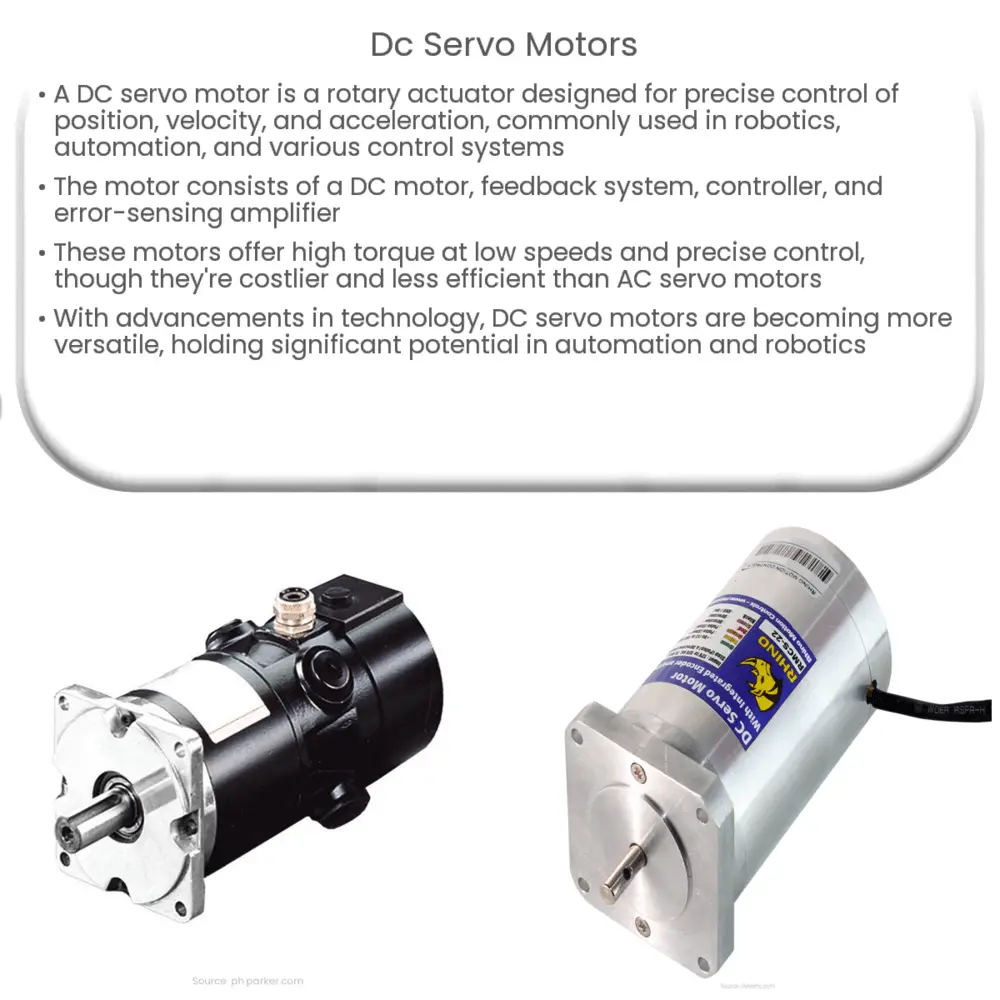Explore the fundamentals of DC Servo Motors, their working principle, types, and applications in robotics and automation.

Introduction to DC Servo Motors
A DC servo motor is a rotary actuator designed to deliver precise control over angular or linear position, velocity, and acceleration. They are widely used in robotics, automation, and many types of control systems, including those found in industrial machinery, aerospace applications, and even in consumer electronics.
The Basics of DC Servo Motors
At its core, a DC servo motor comprises a DC motor, a feedback system, a controller, and an error-sensing amplifier. The feedback mechanism, often an encoder or resolver, continually adjusts the output in response to changing conditions, thereby ensuring the motor accurately follows the control input.
Components of a DC Servo Motor
- DC Motor: This is the basic drive unit that generates rotary motion. It typically features a stator (stationary field winding) and an armature (rotating winding).
- Feedback System: This component measures the output of the motor (position, velocity, or acceleration) and sends this information back to the controller for comparison with the input command.
- Controller: This unit receives the input command and compares it with the feedback from the motor. If there is a discrepancy, it generates an error signal.
- Error Sensing Amplifier: This amplifies the error signal from the controller and sends it to the DC motor for correction. The amplified error signal is used to adjust the speed and direction of the motor.
Advantages and Disadvantages of DC Servo Motors
DC servo motors have several advantages that make them suitable for a wide range of applications. Notably, they offer high torque at low speed, excellent response characteristics, and precise control of position and speed. Additionally, they are straightforward to implement and control.
However, they also come with some disadvantages. DC servo motors are more expensive than other types of motors and require more complex control systems. They also generate more heat and are less efficient compared to AC servo motors.
Applications of DC Servo Motors
The precision control offered by DC servo motors makes them ideal for many applications. They are commonly used in robotics, automated manufacturing, aerospace, and more. For instance, in robotics, these motors enable accurate movement control of robot arms, while in automated manufacturing, they help ensure the precise placement of components on a production line.
Detailed Working Principle of DC Servo Motors
The operation of a DC servo motor is based on the principles of feedback and error correction. When the system receives a command signal, the motor starts to move and generates a position feedback. This feedback signal is compared with the command signal. If any difference is found between these two signals (known as error), the controller generates an error correction signal. This signal, amplified by the error sensing amplifier, directs the motor to adjust its position, speed, or acceleration to match the command input.
The Role of Controllers in DC Servo Motors
The controller is an essential part of the DC servo motor system as it provides the crucial interface between the motor and the controlling device. It interprets the command signal and manages the feedback loop, enabling precise control over the motor’s operation. Various types of controllers are used in DC servo systems, ranging from simple PID (Proportional-Integral-Derivative) controllers to more sophisticated programmable logic controllers (PLCs).
Types of DC Servo Motors
- Brushed DC Servo Motors: These motors use physical brushes to transfer electrical current to the motor’s rotating part, the rotor. They offer excellent torque and speed control but require regular maintenance due to brush wear.
- Brushless DC Servo Motors: As the name suggests, these motors eliminate the use of brushes, making them more reliable and efficient. However, they require more complex controllers.
Future of DC Servo Motors
With advancements in control technology and materials, DC servo motors are becoming more efficient, reliable, and adaptable to a wider range of applications. Developments in fields like IoT and AI are opening new possibilities for smart, connected, and autonomous systems, where DC servo motors will play an integral role.
Conclusion
In conclusion, DC servo motors are indispensable for many applications that require precise control over motion. Their unique characteristics of high torque at low speed, excellent response, and precision make them an ideal choice in many fields. Despite some disadvantages, the continual advances in technology are set to mitigate these issues, expanding the potential applications for DC servo motors. As we look to the future, these versatile devices will continue to be a vital component in the evolution of automation, robotics, and other advanced control systems.

